University Biology Report: Diabetes Etiology, Symptoms, and Care Plan
VerifiedAdded on 2023/06/10
|9
|1720
|317
Report
AI Summary
This research paper provides a comprehensive overview of diabetes, a metabolic disorder characterized by high blood glucose levels. It delves into the normal anatomy and physiology of the body, focusing on the roles of insulin and glucagon in maintaining blood sugar balance. The paper explores the etiology and risk factors of diabetes, differentiating between Type 1, Type 2, and gestational diabetes, and highlighting genetic, lifestyle, and environmental influences. It details the various body systems affected by diabetes, including the cardiovascular system, eyes, and nervous system, and discusses the symptoms and potential complications. The report also outlines the management strategies for diabetes, emphasizing the importance of blood sugar monitoring, insulin therapy, healthy eating, hydration, and exercise. The paper concludes by stressing the chronic nature of diabetes and the importance of ongoing management through lifestyle modifications and medical interventions.
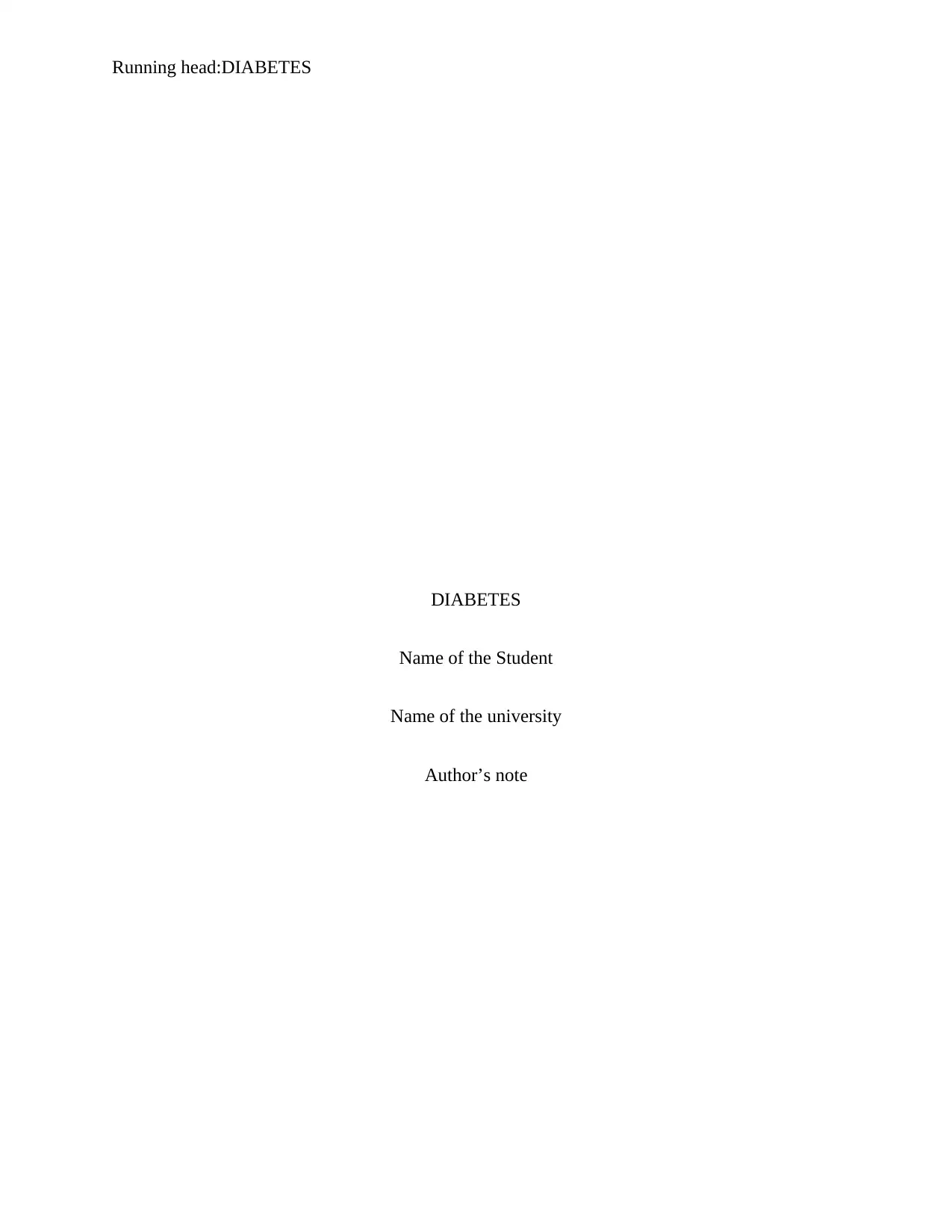
Running head:DIABETES
DIABETES
Name of the Student
Name of the university
Author’s note
DIABETES
Name of the Student
Name of the university
Author’s note
Paraphrase This Document
Need a fresh take? Get an instant paraphrase of this document with our AI Paraphraser
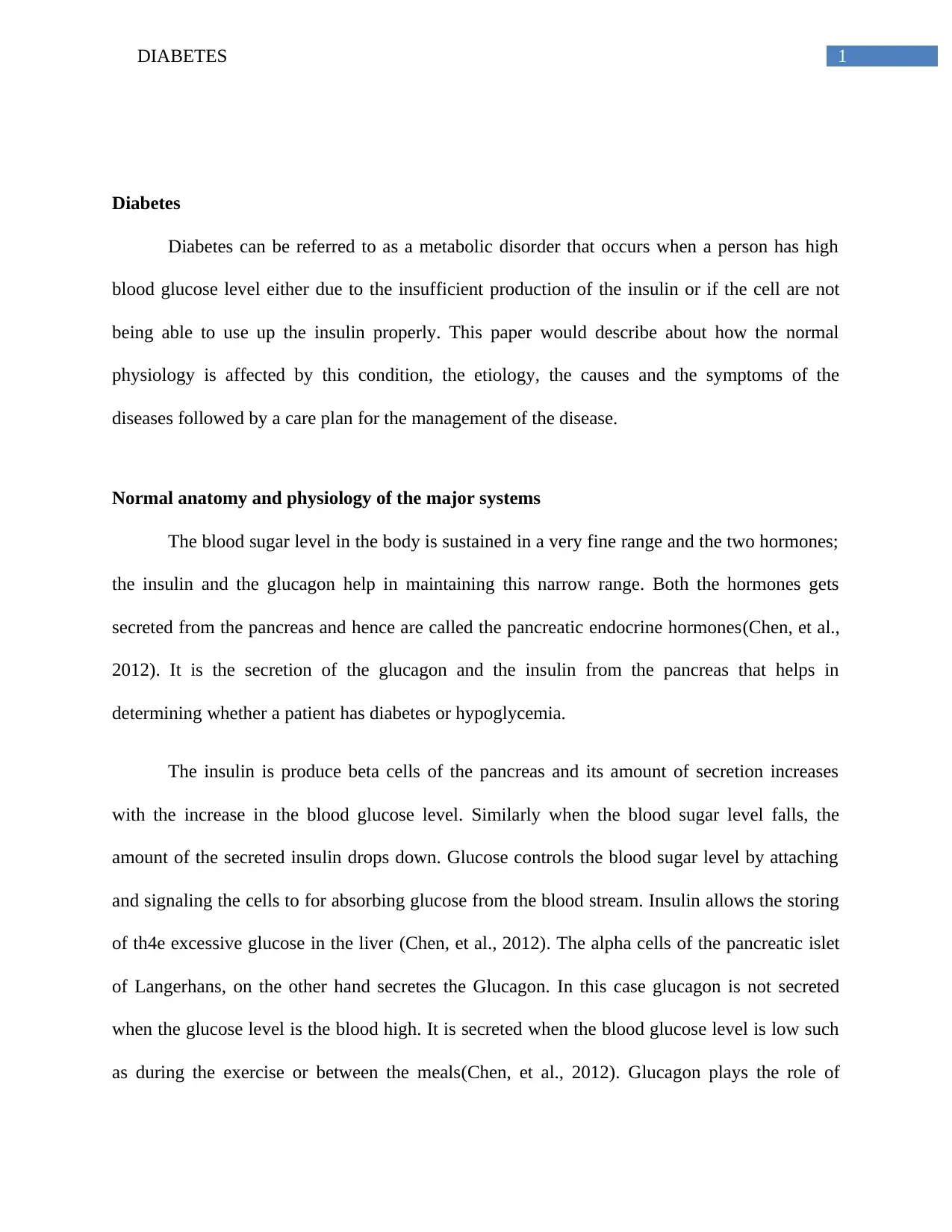
1DIABETES
Diabetes
Diabetes can be referred to as a metabolic disorder that occurs when a person has high
blood glucose level either due to the insufficient production of the insulin or if the cell are not
being able to use up the insulin properly. This paper would describe about how the normal
physiology is affected by this condition, the etiology, the causes and the symptoms of the
diseases followed by a care plan for the management of the disease.
Normal anatomy and physiology of the major systems
The blood sugar level in the body is sustained in a very fine range and the two hormones;
the insulin and the glucagon help in maintaining this narrow range. Both the hormones gets
secreted from the pancreas and hence are called the pancreatic endocrine hormones(Chen, et al.,
2012). It is the secretion of the glucagon and the insulin from the pancreas that helps in
determining whether a patient has diabetes or hypoglycemia.
The insulin is produce beta cells of the pancreas and its amount of secretion increases
with the increase in the blood glucose level. Similarly when the blood sugar level falls, the
amount of the secreted insulin drops down. Glucose controls the blood sugar level by attaching
and signaling the cells to for absorbing glucose from the blood stream. Insulin allows the storing
of th4e excessive glucose in the liver (Chen, et al., 2012). The alpha cells of the pancreatic islet
of Langerhans, on the other hand secretes the Glucagon. In this case glucagon is not secreted
when the glucose level is the blood high. It is secreted when the blood glucose level is low such
as during the exercise or between the meals(Chen, et al., 2012). Glucagon plays the role of
Diabetes
Diabetes can be referred to as a metabolic disorder that occurs when a person has high
blood glucose level either due to the insufficient production of the insulin or if the cell are not
being able to use up the insulin properly. This paper would describe about how the normal
physiology is affected by this condition, the etiology, the causes and the symptoms of the
diseases followed by a care plan for the management of the disease.
Normal anatomy and physiology of the major systems
The blood sugar level in the body is sustained in a very fine range and the two hormones;
the insulin and the glucagon help in maintaining this narrow range. Both the hormones gets
secreted from the pancreas and hence are called the pancreatic endocrine hormones(Chen, et al.,
2012). It is the secretion of the glucagon and the insulin from the pancreas that helps in
determining whether a patient has diabetes or hypoglycemia.
The insulin is produce beta cells of the pancreas and its amount of secretion increases
with the increase in the blood glucose level. Similarly when the blood sugar level falls, the
amount of the secreted insulin drops down. Glucose controls the blood sugar level by attaching
and signaling the cells to for absorbing glucose from the blood stream. Insulin allows the storing
of th4e excessive glucose in the liver (Chen, et al., 2012). The alpha cells of the pancreatic islet
of Langerhans, on the other hand secretes the Glucagon. In this case glucagon is not secreted
when the glucose level is the blood high. It is secreted when the blood glucose level is low such
as during the exercise or between the meals(Chen, et al., 2012). Glucagon plays the role of
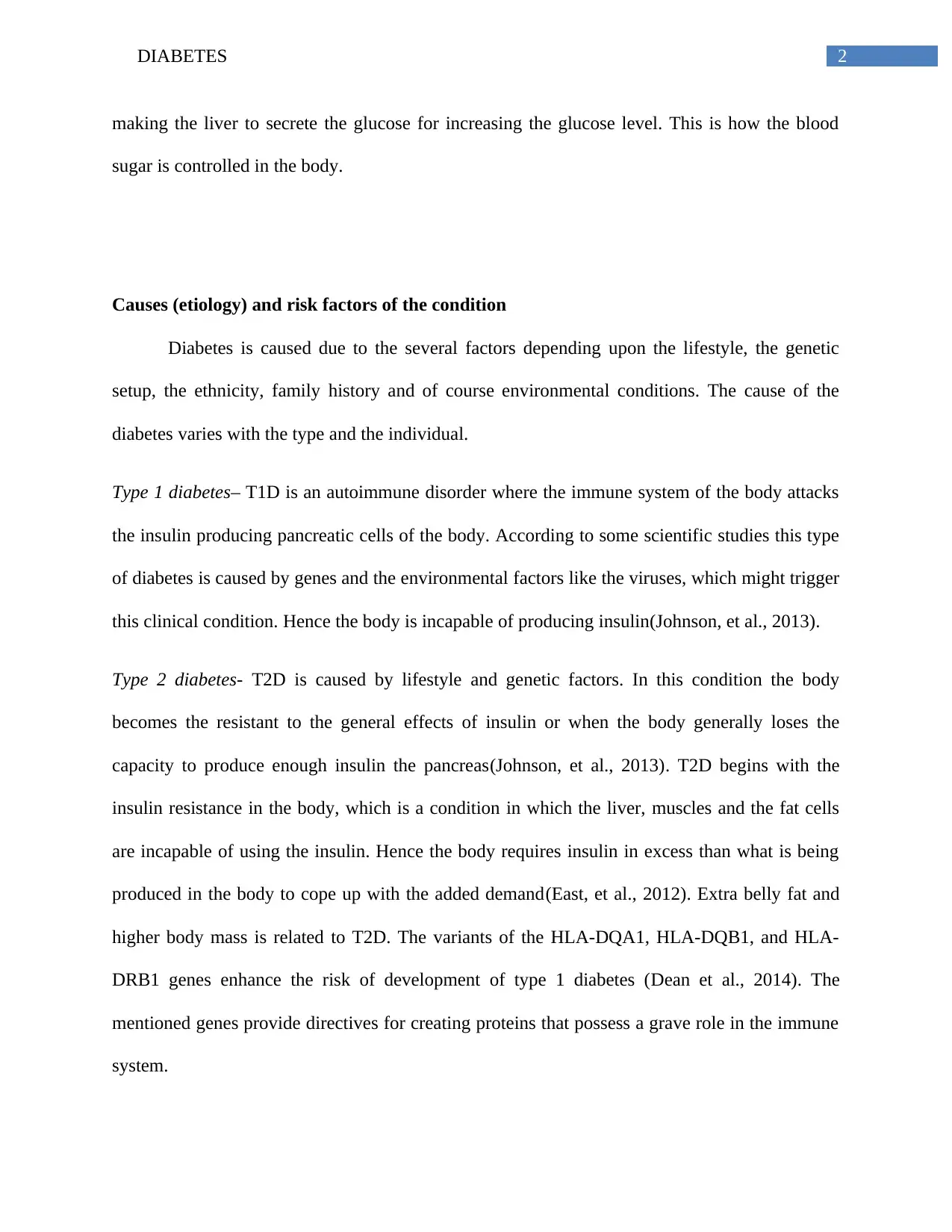
2DIABETES
making the liver to secrete the glucose for increasing the glucose level. This is how the blood
sugar is controlled in the body.
Causes (etiology) and risk factors of the condition
Diabetes is caused due to the several factors depending upon the lifestyle, the genetic
setup, the ethnicity, family history and of course environmental conditions. The cause of the
diabetes varies with the type and the individual.
Type 1 diabetes– T1D is an autoimmune disorder where the immune system of the body attacks
the insulin producing pancreatic cells of the body. According to some scientific studies this type
of diabetes is caused by genes and the environmental factors like the viruses, which might trigger
this clinical condition. Hence the body is incapable of producing insulin(Johnson, et al., 2013).
Type 2 diabetes- T2D is caused by lifestyle and genetic factors. In this condition the body
becomes the resistant to the general effects of insulin or when the body generally loses the
capacity to produce enough insulin the pancreas(Johnson, et al., 2013). T2D begins with the
insulin resistance in the body, which is a condition in which the liver, muscles and the fat cells
are incapable of using the insulin. Hence the body requires insulin in excess than what is being
produced in the body to cope up with the added demand(East, et al., 2012). Extra belly fat and
higher body mass is related to T2D. The variants of the HLA-DQA1, HLA-DQB1, and HLA-
DRB1 genes enhance the risk of development of type 1 diabetes (Dean et al., 2014). The
mentioned genes provide directives for creating proteins that possess a grave role in the immune
system.
making the liver to secrete the glucose for increasing the glucose level. This is how the blood
sugar is controlled in the body.
Causes (etiology) and risk factors of the condition
Diabetes is caused due to the several factors depending upon the lifestyle, the genetic
setup, the ethnicity, family history and of course environmental conditions. The cause of the
diabetes varies with the type and the individual.
Type 1 diabetes– T1D is an autoimmune disorder where the immune system of the body attacks
the insulin producing pancreatic cells of the body. According to some scientific studies this type
of diabetes is caused by genes and the environmental factors like the viruses, which might trigger
this clinical condition. Hence the body is incapable of producing insulin(Johnson, et al., 2013).
Type 2 diabetes- T2D is caused by lifestyle and genetic factors. In this condition the body
becomes the resistant to the general effects of insulin or when the body generally loses the
capacity to produce enough insulin the pancreas(Johnson, et al., 2013). T2D begins with the
insulin resistance in the body, which is a condition in which the liver, muscles and the fat cells
are incapable of using the insulin. Hence the body requires insulin in excess than what is being
produced in the body to cope up with the added demand(East, et al., 2012). Extra belly fat and
higher body mass is related to T2D. The variants of the HLA-DQA1, HLA-DQB1, and HLA-
DRB1 genes enhance the risk of development of type 1 diabetes (Dean et al., 2014). The
mentioned genes provide directives for creating proteins that possess a grave role in the immune
system.
⊘ This is a preview!⊘
Do you want full access?
Subscribe today to unlock all pages.

Trusted by 1+ million students worldwide
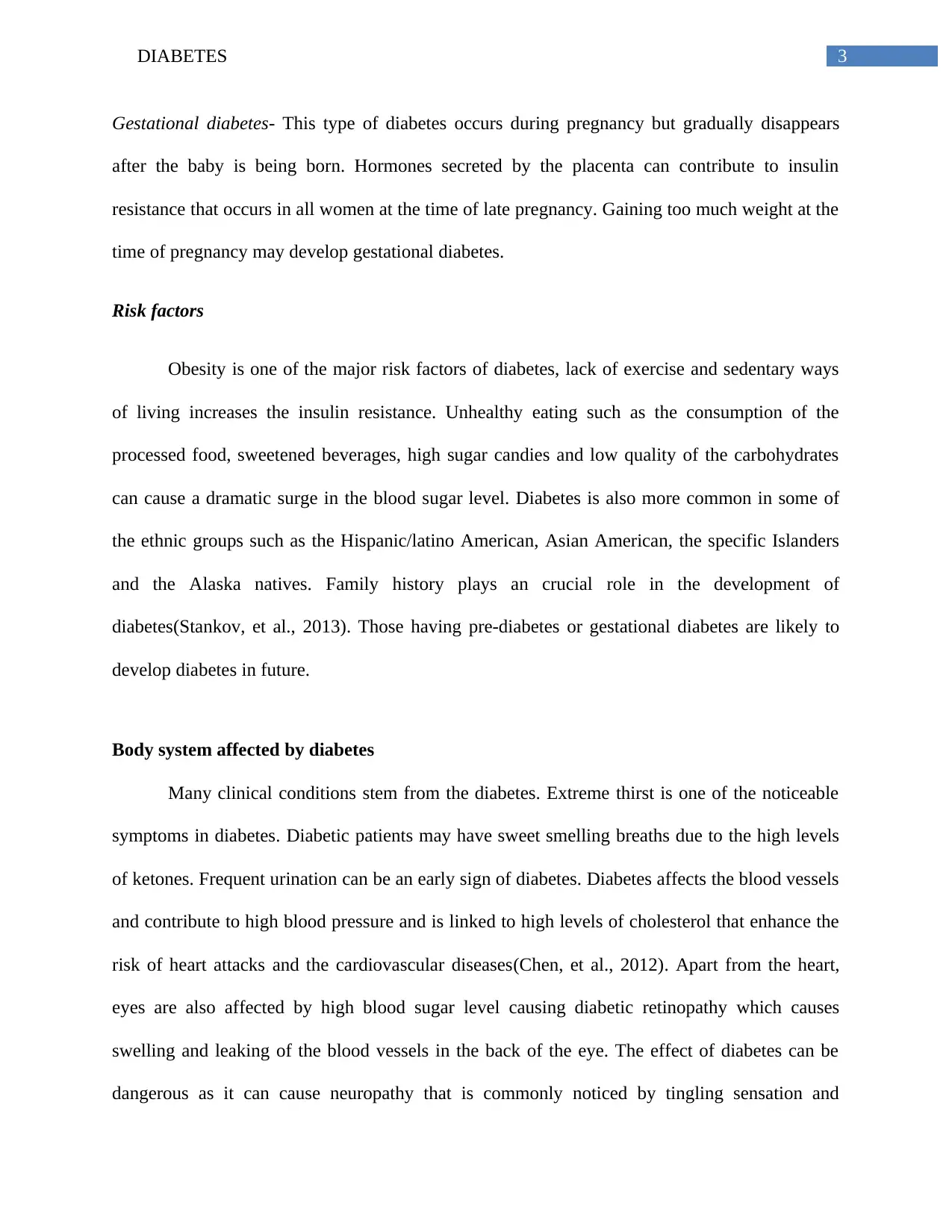
3DIABETES
Gestational diabetes- This type of diabetes occurs during pregnancy but gradually disappears
after the baby is being born. Hormones secreted by the placenta can contribute to insulin
resistance that occurs in all women at the time of late pregnancy. Gaining too much weight at the
time of pregnancy may develop gestational diabetes.
Risk factors
Obesity is one of the major risk factors of diabetes, lack of exercise and sedentary ways
of living increases the insulin resistance. Unhealthy eating such as the consumption of the
processed food, sweetened beverages, high sugar candies and low quality of the carbohydrates
can cause a dramatic surge in the blood sugar level. Diabetes is also more common in some of
the ethnic groups such as the Hispanic/latino American, Asian American, the specific Islanders
and the Alaska natives. Family history plays an crucial role in the development of
diabetes(Stankov, et al., 2013). Those having pre-diabetes or gestational diabetes are likely to
develop diabetes in future.
Body system affected by diabetes
Many clinical conditions stem from the diabetes. Extreme thirst is one of the noticeable
symptoms in diabetes. Diabetic patients may have sweet smelling breaths due to the high levels
of ketones. Frequent urination can be an early sign of diabetes. Diabetes affects the blood vessels
and contribute to high blood pressure and is linked to high levels of cholesterol that enhance the
risk of heart attacks and the cardiovascular diseases(Chen, et al., 2012). Apart from the heart,
eyes are also affected by high blood sugar level causing diabetic retinopathy which causes
swelling and leaking of the blood vessels in the back of the eye. The effect of diabetes can be
dangerous as it can cause neuropathy that is commonly noticed by tingling sensation and
Gestational diabetes- This type of diabetes occurs during pregnancy but gradually disappears
after the baby is being born. Hormones secreted by the placenta can contribute to insulin
resistance that occurs in all women at the time of late pregnancy. Gaining too much weight at the
time of pregnancy may develop gestational diabetes.
Risk factors
Obesity is one of the major risk factors of diabetes, lack of exercise and sedentary ways
of living increases the insulin resistance. Unhealthy eating such as the consumption of the
processed food, sweetened beverages, high sugar candies and low quality of the carbohydrates
can cause a dramatic surge in the blood sugar level. Diabetes is also more common in some of
the ethnic groups such as the Hispanic/latino American, Asian American, the specific Islanders
and the Alaska natives. Family history plays an crucial role in the development of
diabetes(Stankov, et al., 2013). Those having pre-diabetes or gestational diabetes are likely to
develop diabetes in future.
Body system affected by diabetes
Many clinical conditions stem from the diabetes. Extreme thirst is one of the noticeable
symptoms in diabetes. Diabetic patients may have sweet smelling breaths due to the high levels
of ketones. Frequent urination can be an early sign of diabetes. Diabetes affects the blood vessels
and contribute to high blood pressure and is linked to high levels of cholesterol that enhance the
risk of heart attacks and the cardiovascular diseases(Chen, et al., 2012). Apart from the heart,
eyes are also affected by high blood sugar level causing diabetic retinopathy which causes
swelling and leaking of the blood vessels in the back of the eye. The effect of diabetes can be
dangerous as it can cause neuropathy that is commonly noticed by tingling sensation and
Paraphrase This Document
Need a fresh take? Get an instant paraphrase of this document with our AI Paraphraser
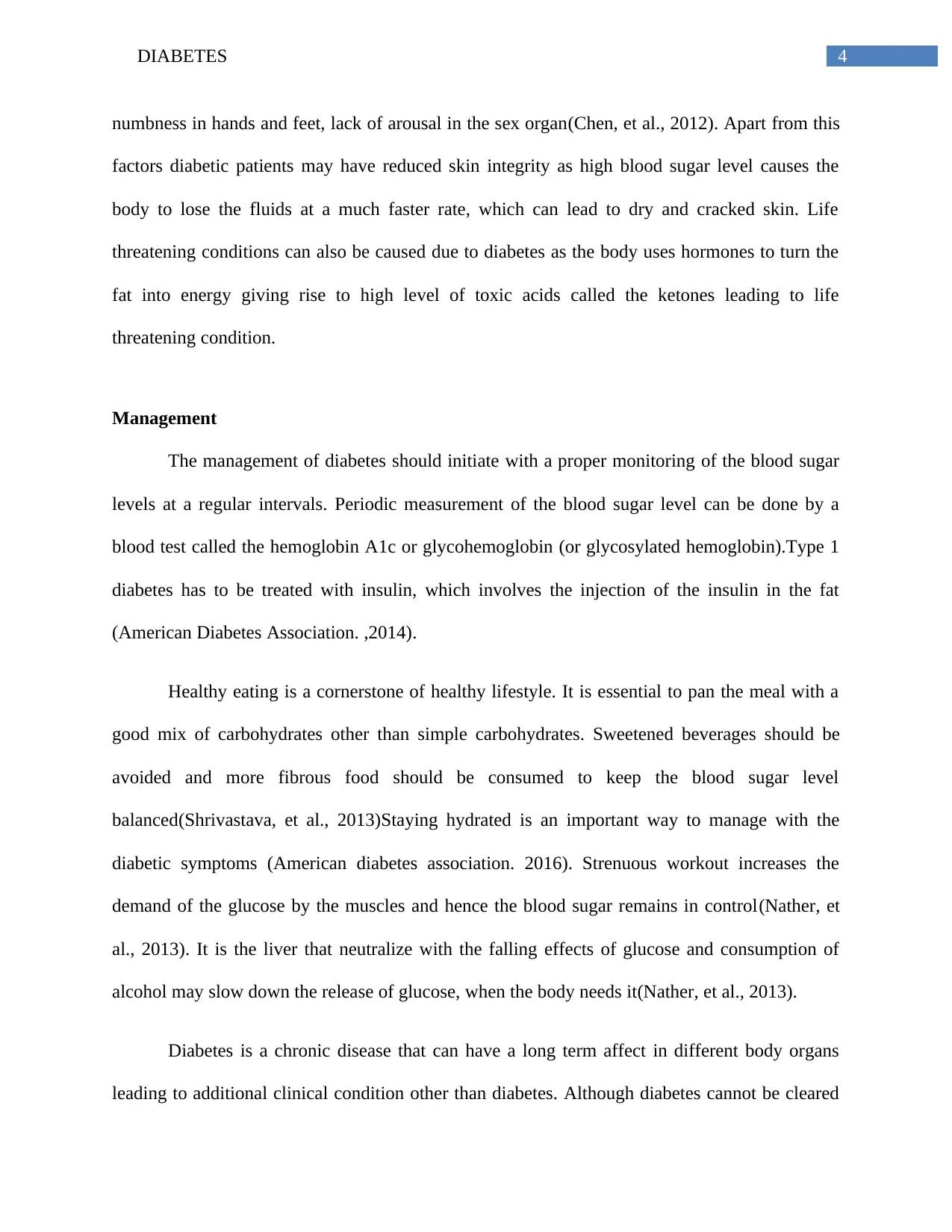
4DIABETES
numbness in hands and feet, lack of arousal in the sex organ(Chen, et al., 2012). Apart from this
factors diabetic patients may have reduced skin integrity as high blood sugar level causes the
body to lose the fluids at a much faster rate, which can lead to dry and cracked skin. Life
threatening conditions can also be caused due to diabetes as the body uses hormones to turn the
fat into energy giving rise to high level of toxic acids called the ketones leading to life
threatening condition.
Management
The management of diabetes should initiate with a proper monitoring of the blood sugar
levels at a regular intervals. Periodic measurement of the blood sugar level can be done by a
blood test called the hemoglobin A1c or glycohemoglobin (or glycosylated hemoglobin).Type 1
diabetes has to be treated with insulin, which involves the injection of the insulin in the fat
(American Diabetes Association. ,2014).
Healthy eating is a cornerstone of healthy lifestyle. It is essential to pan the meal with a
good mix of carbohydrates other than simple carbohydrates. Sweetened beverages should be
avoided and more fibrous food should be consumed to keep the blood sugar level
balanced(Shrivastava, et al., 2013)Staying hydrated is an important way to manage with the
diabetic symptoms (American diabetes association. 2016). Strenuous workout increases the
demand of the glucose by the muscles and hence the blood sugar remains in control(Nather, et
al., 2013). It is the liver that neutralize with the falling effects of glucose and consumption of
alcohol may slow down the release of glucose, when the body needs it(Nather, et al., 2013).
Diabetes is a chronic disease that can have a long term affect in different body organs
leading to additional clinical condition other than diabetes. Although diabetes cannot be cleared
numbness in hands and feet, lack of arousal in the sex organ(Chen, et al., 2012). Apart from this
factors diabetic patients may have reduced skin integrity as high blood sugar level causes the
body to lose the fluids at a much faster rate, which can lead to dry and cracked skin. Life
threatening conditions can also be caused due to diabetes as the body uses hormones to turn the
fat into energy giving rise to high level of toxic acids called the ketones leading to life
threatening condition.
Management
The management of diabetes should initiate with a proper monitoring of the blood sugar
levels at a regular intervals. Periodic measurement of the blood sugar level can be done by a
blood test called the hemoglobin A1c or glycohemoglobin (or glycosylated hemoglobin).Type 1
diabetes has to be treated with insulin, which involves the injection of the insulin in the fat
(American Diabetes Association. ,2014).
Healthy eating is a cornerstone of healthy lifestyle. It is essential to pan the meal with a
good mix of carbohydrates other than simple carbohydrates. Sweetened beverages should be
avoided and more fibrous food should be consumed to keep the blood sugar level
balanced(Shrivastava, et al., 2013)Staying hydrated is an important way to manage with the
diabetic symptoms (American diabetes association. 2016). Strenuous workout increases the
demand of the glucose by the muscles and hence the blood sugar remains in control(Nather, et
al., 2013). It is the liver that neutralize with the falling effects of glucose and consumption of
alcohol may slow down the release of glucose, when the body needs it(Nather, et al., 2013).
Diabetes is a chronic disease that can have a long term affect in different body organs
leading to additional clinical condition other than diabetes. Although diabetes cannot be cleared

5DIABETES
from the root, but the blood sugar levels can be managed by adopting suitable food habits, active
life style and adherence to proper medications.
from the root, but the blood sugar levels can be managed by adopting suitable food habits, active
life style and adherence to proper medications.
⊘ This is a preview!⊘
Do you want full access?
Subscribe today to unlock all pages.

Trusted by 1+ million students worldwide
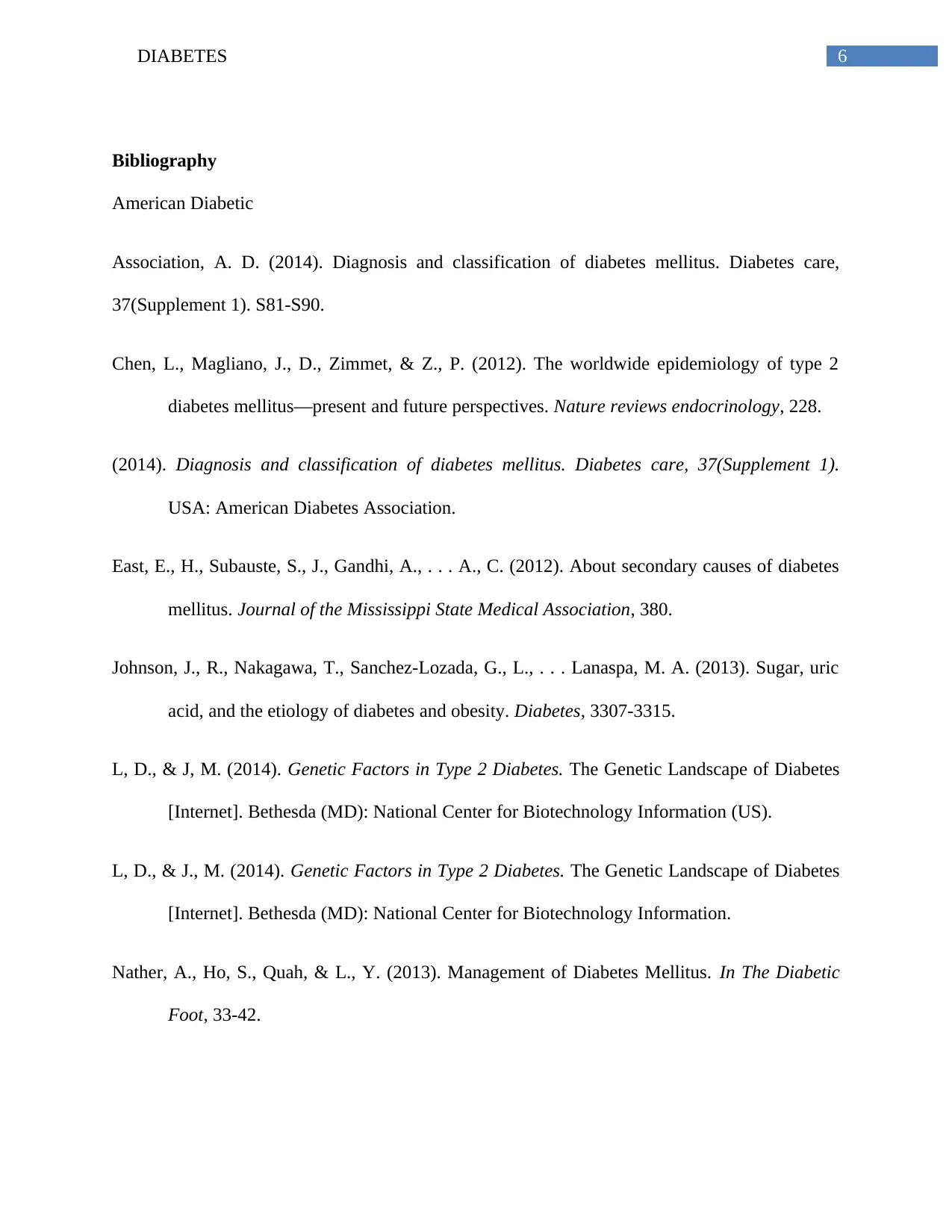
6DIABETES
Bibliography
American Diabetic
Association, A. D. (2014). Diagnosis and classification of diabetes mellitus. Diabetes care,
37(Supplement 1). S81-S90.
Chen, L., Magliano, J., D., Zimmet, & Z., P. (2012). The worldwide epidemiology of type 2
diabetes mellitus—present and future perspectives. Nature reviews endocrinology, 228.
(2014). Diagnosis and classification of diabetes mellitus. Diabetes care, 37(Supplement 1).
USA: American Diabetes Association.
East, E., H., Subauste, S., J., Gandhi, A., . . . A., C. (2012). About secondary causes of diabetes
mellitus. Journal of the Mississippi State Medical Association, 380.
Johnson, J., R., Nakagawa, T., Sanchez-Lozada, G., L., . . . Lanaspa, M. A. (2013). Sugar, uric
acid, and the etiology of diabetes and obesity. Diabetes, 3307-3315.
L, D., & J, M. (2014). Genetic Factors in Type 2 Diabetes. The Genetic Landscape of Diabetes
[Internet]. Bethesda (MD): National Center for Biotechnology Information (US).
L, D., & J., M. (2014). Genetic Factors in Type 2 Diabetes. The Genetic Landscape of Diabetes
[Internet]. Bethesda (MD): National Center for Biotechnology Information.
Nather, A., Ho, S., Quah, & L., Y. (2013). Management of Diabetes Mellitus. In The Diabetic
Foot, 33-42.
Bibliography
American Diabetic
Association, A. D. (2014). Diagnosis and classification of diabetes mellitus. Diabetes care,
37(Supplement 1). S81-S90.
Chen, L., Magliano, J., D., Zimmet, & Z., P. (2012). The worldwide epidemiology of type 2
diabetes mellitus—present and future perspectives. Nature reviews endocrinology, 228.
(2014). Diagnosis and classification of diabetes mellitus. Diabetes care, 37(Supplement 1).
USA: American Diabetes Association.
East, E., H., Subauste, S., J., Gandhi, A., . . . A., C. (2012). About secondary causes of diabetes
mellitus. Journal of the Mississippi State Medical Association, 380.
Johnson, J., R., Nakagawa, T., Sanchez-Lozada, G., L., . . . Lanaspa, M. A. (2013). Sugar, uric
acid, and the etiology of diabetes and obesity. Diabetes, 3307-3315.
L, D., & J, M. (2014). Genetic Factors in Type 2 Diabetes. The Genetic Landscape of Diabetes
[Internet]. Bethesda (MD): National Center for Biotechnology Information (US).
L, D., & J., M. (2014). Genetic Factors in Type 2 Diabetes. The Genetic Landscape of Diabetes
[Internet]. Bethesda (MD): National Center for Biotechnology Information.
Nather, A., Ho, S., Quah, & L., Y. (2013). Management of Diabetes Mellitus. In The Diabetic
Foot, 33-42.
Paraphrase This Document
Need a fresh take? Get an instant paraphrase of this document with our AI Paraphraser

7DIABETES
Shrivastava, R., S., Shrivastava, S., P., Ramasamy, & J. (2013). Role of self-care in management
of diabetes mellitus. Journal of Diabetes & Metabolic Disorders, 14.
Stankov, K., Benc, D., Draskovic, & D. (2013). Genetic and epigenetic factors in etiology of
diabetes mellitus type 1. Pediatrics, peds-2013.
Shrivastava, R., S., Shrivastava, S., P., Ramasamy, & J. (2013). Role of self-care in management
of diabetes mellitus. Journal of Diabetes & Metabolic Disorders, 14.
Stankov, K., Benc, D., Draskovic, & D. (2013). Genetic and epigenetic factors in etiology of
diabetes mellitus type 1. Pediatrics, peds-2013.

8DIABETES
⊘ This is a preview!⊘
Do you want full access?
Subscribe today to unlock all pages.

Trusted by 1+ million students worldwide
1 out of 9
Related Documents
Your All-in-One AI-Powered Toolkit for Academic Success.
+13062052269
info@desklib.com
Available 24*7 on WhatsApp / Email
![[object Object]](/_next/static/media/star-bottom.7253800d.svg)
Unlock your academic potential
Copyright © 2020–2025 A2Z Services. All Rights Reserved. Developed and managed by ZUCOL.





